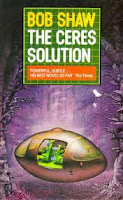The Ceres Solution is a story of world's (metaphorically) colliding*, as told through the eyes of two unlikely people. One world is Mollan, a former Earth colony, now evolved into a quasi-utopian society. World peace exists, people live for hundreds and hundreds of years, technology like magic exists, and the individual is free to pursue their interests. This includes Gretana, a young woman who goes to Earth to act as an observer for Mollan society. And the other world is indeed, Earth. An unevolved version of our Earth, crime, depravity, and vice run rampant. Hargate is a bitter young man who grows up in these conditions, exacerbated by the fact he is confined to a wheelchair. But upon completing his education, he receives the opportunity of a lifetime—to go into space, a place where his lack of legs means significantly less. Eventually, Gretana and Hargate meet, and that is where The Ceres Solution attempts to come to terms with its utopian/dystopian dichotomy.
Shaw's prose is surprisingly sharp and precise. The early part of the novel struggles to get off the ground due to the lack of necessity for certain scenes and weak transitions, but word for word, line for line, it reads squeaky clean. I'm not the greatest Shaw reader, but of what little I've read, the diction here is on point.
If indeed there are any post-graduate students out there, looking for potential source material, be aware The Ceres Solution does not explore utopias/dystopias to a significant degree. If I were a technician, I would calibrate the novel as 70% character drama, 30% everything else, including the bare details of the utopian/dystopian settings. Where the novel may be of interest in this area is the way he deconstructs them from within. I won't spoil matters here, but for the curious, Shaw does put a bit of effort into ensuring things do not remain purely black/white.
In the end, The Ceres Solution has been largely lost to time. Whether or not this is for good reason will depend on how much the reader is excited by the idea of a utopian alien setting vs a dystopian Earth setting, as glued together by characters experiencing a conspiracy theory—of sorts. People looking for three Ds of human presentation or complex plotting should look elsewhere. If anything, Shaw holds up his end of the bargain through lean, clear prose. Post-grads, take all this as you will.
*This is a science fiction review. Such qualifiers are naturally required.


No comments:
Post a Comment